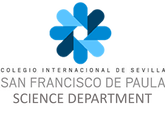- Department Home page
- MYP Year 6
-
MYP Year 7
-
MYP Year 8
- MYP Year 9
-
MYP Year 10
- Yr10 Syllabus
-
Contents
>
- Unit 0 - Formulation
- Unit 1 - Scientific Activity
- Unit 2 - Kinetic theory
- The Atmosphere
- Unit 3 - Mixtures and pures substances: Colligative properties
- Unit 4 - The structure of matter
- Unit 5 - Stoichiometry
- Unit 6 - Redox Reactions
- Unit 7 - Movement
- Unit 8 - Forces
- Unit 9 - Electricity
- Unit 10 - Energy
- Revision
- Assessments and Lab Sessionss >
- PISA questions
- DP Biology SL
- Biología 12º
- IB Biología NS
-
IB Chemistry HL
-
Other resources for students
- Department Home page
- MYP Year 6
-
MYP Year 7
-
MYP Year 8
- MYP Year 9
-
MYP Year 10
- Yr10 Syllabus
-
Contents
>
- Unit 0 - Formulation
- Unit 1 - Scientific Activity
- Unit 2 - Kinetic theory
- The Atmosphere
- Unit 3 - Mixtures and pures substances: Colligative properties
- Unit 4 - The structure of matter
- Unit 5 - Stoichiometry
- Unit 6 - Redox Reactions
- Unit 7 - Movement
- Unit 8 - Forces
- Unit 9 - Electricity
- Unit 10 - Energy
- Revision
- Assessments and Lab Sessionss >
- PISA questions
- DP Biology SL
- Biología 12º
- IB Biología NS
-
IB Chemistry HL
-
Other resources for students

